| Original Article, Biomed Biopharm Res., 2023; 20(2):28-42 doi: 10.19277/bbr.20.2.327; Bilingual PDF [+]; Portuguese html [PT] |
Development and Sensory Analysis of Adansonia Digitata L. Fruit-Based Beverages
Agnelo Monteiro 1![]() , Eduardo Gomes 1
, Eduardo Gomes 1![]() , Iuri Lopes 1, Sayra Bal 2, & Leandro Oliveira 3
, Iuri Lopes 1, Sayra Bal 2, & Leandro Oliveira 3 ![]() ✉️
✉️
1 - School of Sciences and Health Technologies, Universidade Lusófona de Humanidades e Tecnologias, Av. Campo Grande 376, 1749-024 Lisbon, Portugal
2 - Department of Nutrition and Dietetics, Health Sciences Faculty, Istinye University, İstanbul 34010, Turkey
3 - CBIOS – Universidade Lusófona’s Research Center for Biosciences & Health Technologies, Campo Grande 376, 1749-024 Lisbon, Portugal
Abstract
Baobab or mucua, the fruit of Baobab tree (Adonsonia digitata L.), has interesting nutritional and functional properties for human health. This study aims to develop and realize a sensory analysis and the purchase intentions of two mucua beverages by a sample of adults residing in Portugal. The beverages were developed containing mucua, water, sugar, and one also included vanilla aroma. Participants were recruited within the academic community in May 2023. The tasters evaluated the sensory characteristics of múcua beverages. The sensory analysis involved 45 tasters who were university students and residents in the Lisbon metropolitan area, and for 80% of participants this was the first time they were tasting mucua. Although no significant differences were observed between the attributes of the beverages when compared, the vanilla flavor obtained a higher score in taste and sweetness (median of 6 (4; 8) in both), while the beverage without vanilla obtained a higher score in taste (median of 7 (4;8)). Some attributes that need improvement were identified, as approximately 30% of participants pointed out texture as a negative aspect in both beverages. It was also found that tasters would be willing to consume the beverages one to four times a week and pay about € 3 per liter for them. These results suggest that mucua-based beverages with and without vanilla aroma have good acceptance by tasters.
Keywords: Mucua, baobab, beverages, sensorial analysis, innovation
To Cite: Monteiro, A. et. al (2023) Development and Sensory Analysis of Adansonia Digitata L. Fruit-Based Beverages. Biomedical and Biopharmaceutical Research, 20(2), 28-42.
Author Correspondence:
Received: 27/10/2023; Accepted: 31/12/2023
Introduction
Fruit-based beverages have been an essential part of the food and beverage industry, providing a variety of tasty and nutritious options for consumers worldwide (1). In 2022, the global fruit juice market reached a size of US$ 147.5 billion (€ 160.8 billion)(2). The market is projected to grow steadily in the coming years, and by 2028, it is expected to reach US$ 189.9 billion (€ 207.0 billion) (2), displaying a Compound Annual Growth Rate (CAGR) of 4.3% during the period from 2022 to 2028. The fruit and vegetable juice market in Europe is expected to exhibit a CAGR of 1.47% over the next five years (3).
However, in a competitive and constantly evolving scenario, the need for innovation in this sector is more pressing than ever (4). The demand for new ideas and innovative practices has become a requirement to maintain relevance, attract new consumers and face the challenges of the 21st century (5).
Over the past ten years, research in the food sector has focused on meeting consumer market needs, developing new healthier food options. Consumers are increasingly seeking natural products that are generally recognized as safe, produced through sustainable technologies and exhibit specific functional properties (6).
High sugar-content fruit drinks and artificial ingredients have lost space for healthier alternatives, with less added sugar and natural ingredients (5,7). Innovation in the fruit beverage sector can focus on developing options with reduced sugar content, organic ingredients, and additional nutrients to meet the demands of consumers concerned with health (5,8). The incorporation of functional ingredients can add nutritional value and attractiveness to fruit beverages, making them not only tasty but also beneficial to health (8).
Adansonia digitata is a deciduous tree that is part of the Malvaceae family (Bombacoideae), included in the genus Adansonia. It is commonly found in arid or semi-arid regions, predominantly in areas of Africa, Madagascar and Australia. Due to its distinctive morphology, this tree is known by several names, the most common being “baobab” or “imbondeiro” or “embondeiro” (9). Mucua or Baobab is the fruit of Adansonia digita L. (Figure 1), and since ancestral times, it has been valued as food and “medicine” by its properties and benefits for human health (10). However, urban growth and the deforestation of forest areas have placed the baobab tree on the red list of endangered species in Angola, as warned by the national director of Biodiversity at the Ministry of the Environment, in Luanda (11). In addition to putting biodiversity at risk, the felling of these trees puts at risk the income of several families who live from the local sale of their fruits (11). Therefore, it is suggested that the valorization of mucua (at a regional and international level) could contribute to the preservation of baobab, as well as encourage its cultivation, and promote the development of the rural economy in Africa (12). The ripe mucua naturally dehydrates in the tree and does not require any artificial process to conserve. The mucua pulp has a slightly sweet acid taste due to its contents of malic acid,citric acid, tartaric acid, ascorbic acid, gallic acid and succinic acid (13,14).
| Figure 1 - Mucua (baobab): fruit and seeds (Source: Rahul et al. 2015 (9)) |
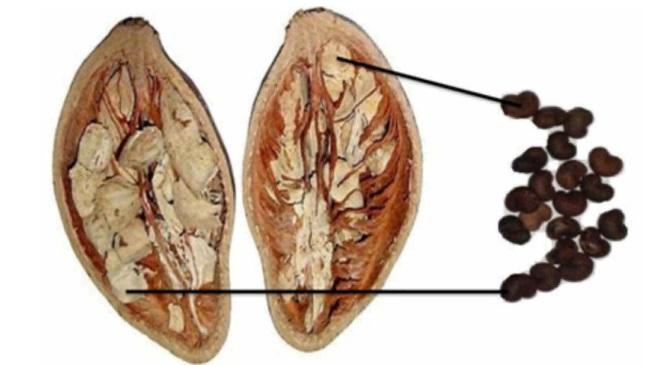 |
In terms of nutritional composition, per 100 g of dry fruit, the mucua contains: 39.2 g of starch, 7.9 g of glucose, 7.0 g fructose, 1.7 g of sucrose, 0.5 g of lipids, 3.0 g proteins, 80.3 g of dietary fibres, 466 mg vitamin C, 309 mg calcium; 775 mg phosphorus, 14.97 mg of iron, and 155 mg of magnesium. It also has bioactive compounds such as phenolic compounds (total phenols: 702.39 mg/100 g fresh weight of mucua Pulp) and carotenoids (total: 0.29 mg/100 g fresh weight of mucua pulp) (15). Biological studies have indicated that mucua pulp has antidiabetic, hepatoprotective, anti-tumor and cardioprotective effects (15). The advantages of developing food products using baobab pulp are diverse due to its nutritional properties. Specifically, the pulp of this fruit can be used in ice cream, yogurts, bakery and pastry products (9), as well as for the development of beverages (16).
Regarding mucua beverages, few studies were found in the literature (16-18). Most of these develop the beverages by mixing 2.5-33.3% of mucua pulp with with another fruit, such as banana, pineapple, black-plum, and tigernut (16,17). Of these studies, only one was conducted in Portugal (18), in which seed roasting was used to develop a beverage similar to coffee; however, this study involved a small sample and in a specified region where the majority of the participants knew the fruit.
In fact, despite its nutritional and health properties, the mucua is not yet well known or easily available in Portugal. It is mostly known by members of African and Afro-descendant communities living in Portugal and is sold in some specialised African shops. The aim of this study was to develop two beverages based on mucua fruit and conduct a sensory analysis, specifically evaluating their acceptability, and explore the willingness of potential consumers to consume them.
Materials and Methods
Preparation of mucua-based beverage
The mucua under study was acquired in a local market in Angola and brought to Portugal. Good food safety practices were observed during transportation, storage, and provision of the mucua pulp to the beverage formulation. Both beverages were prepared following a traditional African recipe, which involved combining the ingredients listed in Table 1. The water was brought to a boil in a container, and once it reached the boiling point, the remaining ingredients were added. They were manually mixed for 10 minutes over low heat. Afterward, the drinks were allowed to cool at room temperature for 30 minutes, filtered to remove some insoluble residues, and then stored under refrigeration (0º-4ºC) until consumption (tasting). Both had a similar composition, differing only in the addition of artificial vanilla flavoring in one of the formulations. Vanilla flavoring was chosen due to its wide acceptance by consumers and its versatility in combination with different sugar concentrations and types of sweeteners (25,26). The cost per liter of mucua-based drinks was also calculated, taking into account only the price of the ingredients in a local supermarket in Angola.
| Table 1 - Composition of the mucua-based beverages, without (A) and with (B) vanilla aroma. |
 |
Sensory analysis
The sensory analysis consisted of an acceptability test with untrained tasters, including students and student workers from Universidade Lusófona – Lisbon, in May 2023. The samples were individually presented in disposable paper cups, accompanied by an online sensory evaluation questionnaire. Access to the questionnaire was provided through a QR code previously made available in paper format. Participants could complete the questionnaire using their own smartphones or tablets or the devices provided by the researchers.
The questionnaire was adapted from a previous study on the sensory analysis of the fruit of Adansonia digitata L. (Baobá) in natura (19), applied to the same target population. The questionnaire consisted of three sections: 1. Socioeconomic characterization (sex, age, education, etc.); 2. Acceptability test using a 9-point hedonic scale (1 - disliked extremely; 9 - liked extremely); 3. Consumption availability (frequency of consumption and willingness to pay).
In the acceptability test, the tasters evaluated the sensory characteristics of mucua, namely: overall appearance, color, taste, aroma, texture, sweetness, and acidity. The consumption availability was assessed with the following question: "To what extent would you be willing to consume this beverage [with or without vanilla flavoring] regularly?" with responses on a five-point scale (1 - not at all; 5 - very much). The frequency of consumption was evaluated with the question: "How often would you be willing to consume the mucua-based beverage [with or without vanilla flavoring] if it were available in the market at an affordable price?" with responses on an 8-point scale (1 - never; 8 - every day). The willingness to pay was assessed with the question: "What price per liter would you be willing to pay for this beverage [with or without vanilla]?" with an open-ended response. The procedures used were those recommended by Teixeira (20) for sensory analysis, namely the provision of 50 ml of the sample and the provision of water for papillary cleansing during the evaluation.
Ethical approval
This work was approved by the Ethics Committee of the School of Health Sciences and Technologies of the Lusófona University (P15-23). All the ethical guidelines established by the 1964 Helsinki Declaration, as well as subsequent amendments and other equivalent ethical norms were followed. Before participating, all volunteers received complete information about the study and gave their informed consent, fully apprised of the objective and procedure of the study. To protect the privacy of the participants, the confidentiality of the collected data was guaranteed, with its exclusive use for this study, and anonymity ensured.
Statistical analysis
The statistical evaluation of this study was conducted using the IBM SPSS Statistics software, version 26 for the Windows operating system. The descriptive analysis included the calculation of medians and percentiles (P25; P75), together with the presentation of absolute (n) and relative frequencies (%). Fisher's exact test was used to verify the independence between paired variables. The Mann-Whitney test was chosen to compare ordered means between independent samples. The null hypothesis was rejected when the p value was less than 0.05.
Results and discussion
The aim of this work was to create two mucua-based drinks and evaluate them on a sensory level, as well as to study their acceptability and purchasing interest among potential consumers.
At the time this study was made, the vanilla-flavored mucua drink with vanilla flavoring had a cost per liter of Kz 219.4 (€ 0.24) and the non-vanilla version of Kz 140 (€ 0.15), respectively.
The sociodemographic characterization of the tasters is presented in Table 2. This study involved 45 tasters who were university students and residents in the Lisbon metropolitan area. Most of them were male (53.3%), Portuguese (77.8%), with a median age of 21 (19; 22.5) years. Approximately 90% of participants reported enjoying trying new foods. For 80% of participants, this study was the first time they were tasting mucua.
| Table 2 - Sociodemographic characteristics of the participants. |
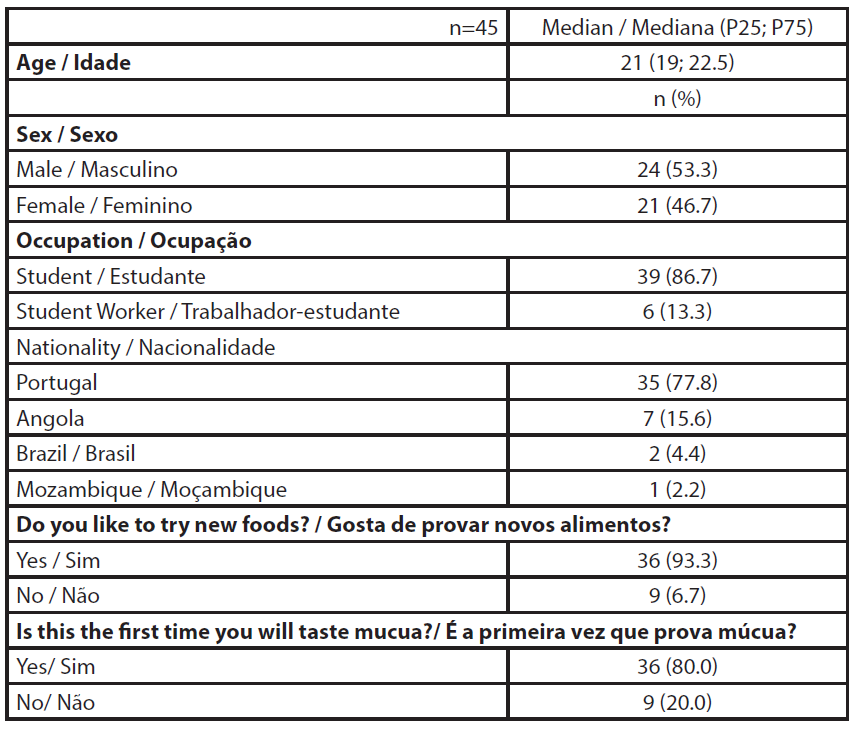 |
Table 3 presents the acceptability test results for the mucua beverage with and without vanilla flavor. For the mucua beverage without vanilla flavor, the taste attribute obtained the highest median score, while the appearance attribute obtained the lowest median score. On the other hand, for the mucua beverage with vanilla, the attributes taste, sweetness, and overall appreciation obtained the highest median scores, while the attributes appearance and color obtained the lowest median scores. There were no significant differences observed between the attributes of the mucua beverages with and without vanilla flavoring.
| Table 3 - Acceptability test of the mucua beverages without and with vanilla aroma (n=45). |
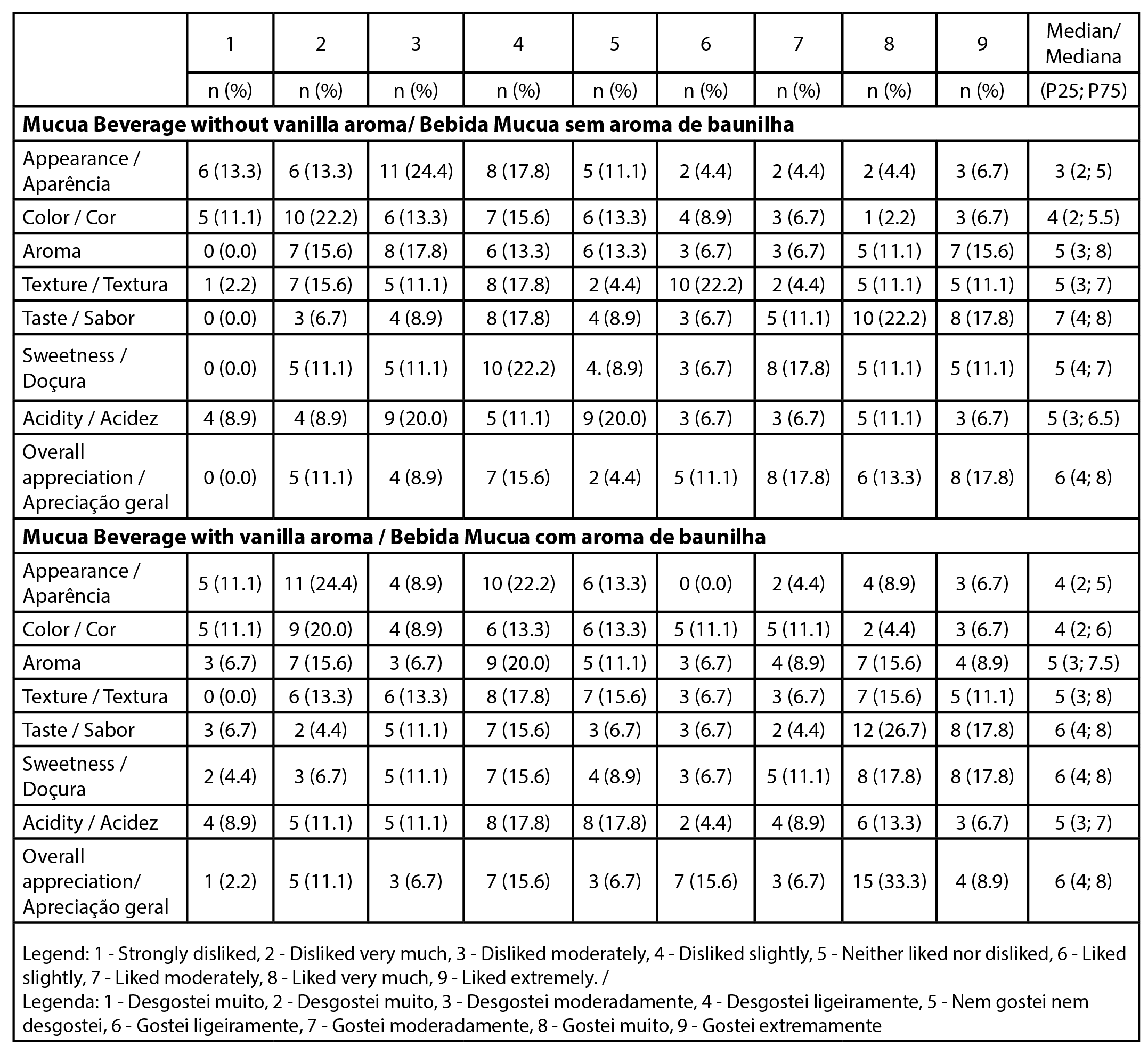 |
These results indicate that in both cases the taste of mucua beverage was well appreciated by the participants. In addition, the inclusion of vanilla flavoring seemed to enhance the attributes of taste, sweetness, and overall appreciation of the mucua beverage. However, it is important to note that appearance and color attributes have received lower scores, suggesting that there may be room for improvements in the visual aspects of the beverage. The presence of vanilla flavoring did not significantly impact the attributes of the mucua beverage, indicating that the addition of vanilla did not drastically alter the overall appreciation of the beverage. In fact, the overall appreciation and taste of these beverages were similar to those of another study with tigernut-mucua beverages (17), but were worse in the color and appearance attributes. Another sensory analysis study (16), involving juice blends from mucua, pineapple, and black-plum fruits, reported lower scores for taste and overall appreciation when compared to the current evaluation of a 100% mucua beverage. This can be explained by the fact that these studies were performed in African countries where the mucua is well known, and therefore tasters are familiar with the aspect, color, texture, and taste of the fruit/ fruit beverages, which is not the case with Portugal.
In the previous study conducted in Portugal (18), one beverage with mucua and another with mucua and banana were developed. The overall appreciation, taste, and the sweetness were the least well-classified attributes for the mucua-based beverage, unlike our study. In this study, individuals who did not know the fruit attributed, in general, lower scores than those who already knew the fruit. As most of our tasters did not know the fruit, this may explain some low scores in some attributes.
Positive and negative aspects of the mucua beverages with and without vanilla flavoring tested in the current study are presented in Table 4. The positive attributes mentioned for the beverages were taste, texture, aroma, and sweetness. Taste was the most mentioned positive aspect in both beverages (with and without vanilla flavoring). This suggests that these elements are the most important for the overall appreciation of beverages among participants. The observation that the taste was the most mentioned attribute as a positive aspect in both beverages reinforces its significant relevance in the sensory analysis. This may indicate that participants consider taste a crucial determinant of their choice and acceptance, corroborating the study of Horlu, Egbadzor, Akuaku, and Akumah (21). On the other hand, the negative attributes mentioned for the beverages were appearance, texture, aroma, sweetness, acidity, and color. Texture was found to be the most mentioned negative aspect in both beverages, specifically the fact that they were "very thick". This suggests that texture is an area of critical concern that may need adjustment to improve beverage acceptance. The attribute of texture was not evaluated in either of the previously published studies regarding beverages with mucua (16,17), however, in the Kivoloka study (18), the “body” of the beverage was evaluated, and a high score was obtained. Again, the familiarity factor with the fruit / mucua beverages may have had some influence.
| Tabele 4 - Positive and negative aspects of the mucua beverages with and without vanilla aroma |
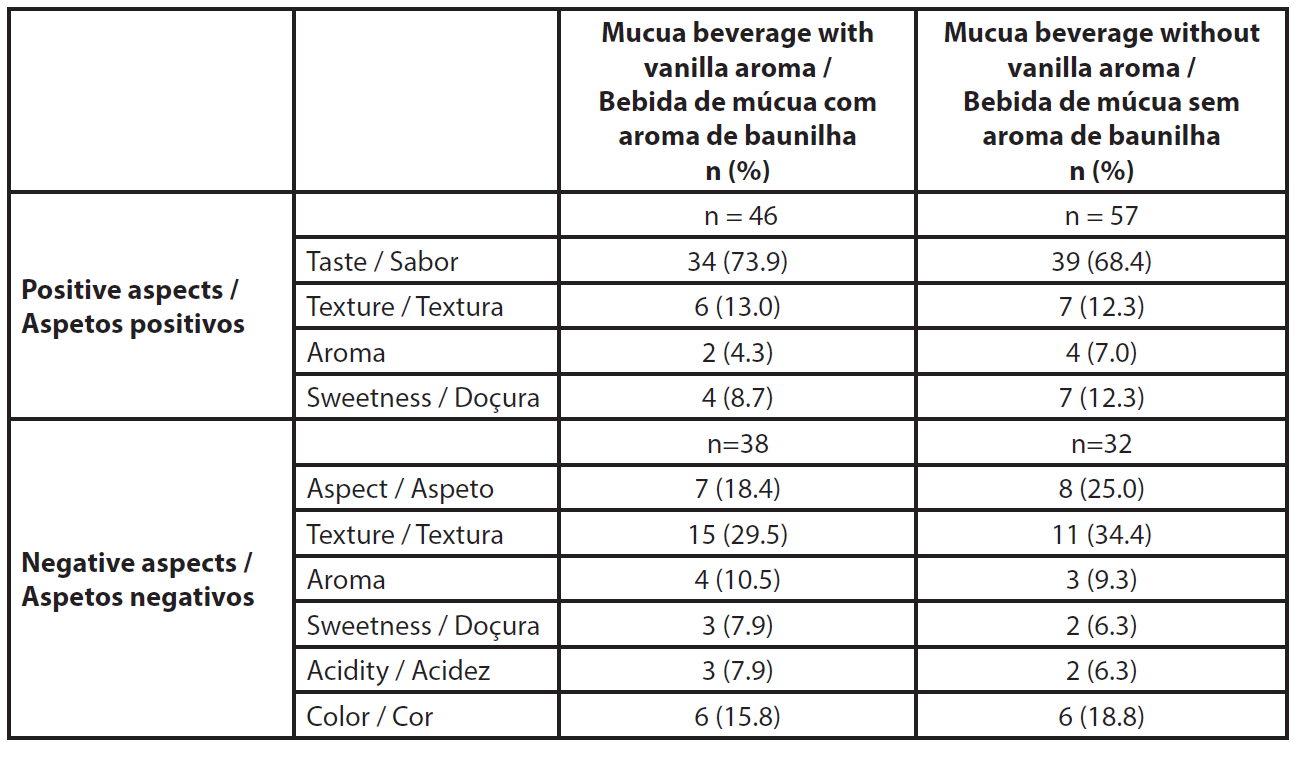 |
Regarding acidity, the mucua has an acidic pH (14), which may not be appealing to some tasters.
Table 5 summarises the willingness to consume and the possible frequency of consumption of mucua-based beverages. The majority of the tasters (64.4%) preferred the beverage without vanilla flavoring. This suggests that among the options available, the vanilla-free version seems to have attracted more participants. This preference may be related to the original taste of the mucua beverage or other sensory characteristics that are more appreciated when not masked by the flavor of vanilla.
| Table 5 - Willingness to consume and frequency of consumption mucua-based beverages. |
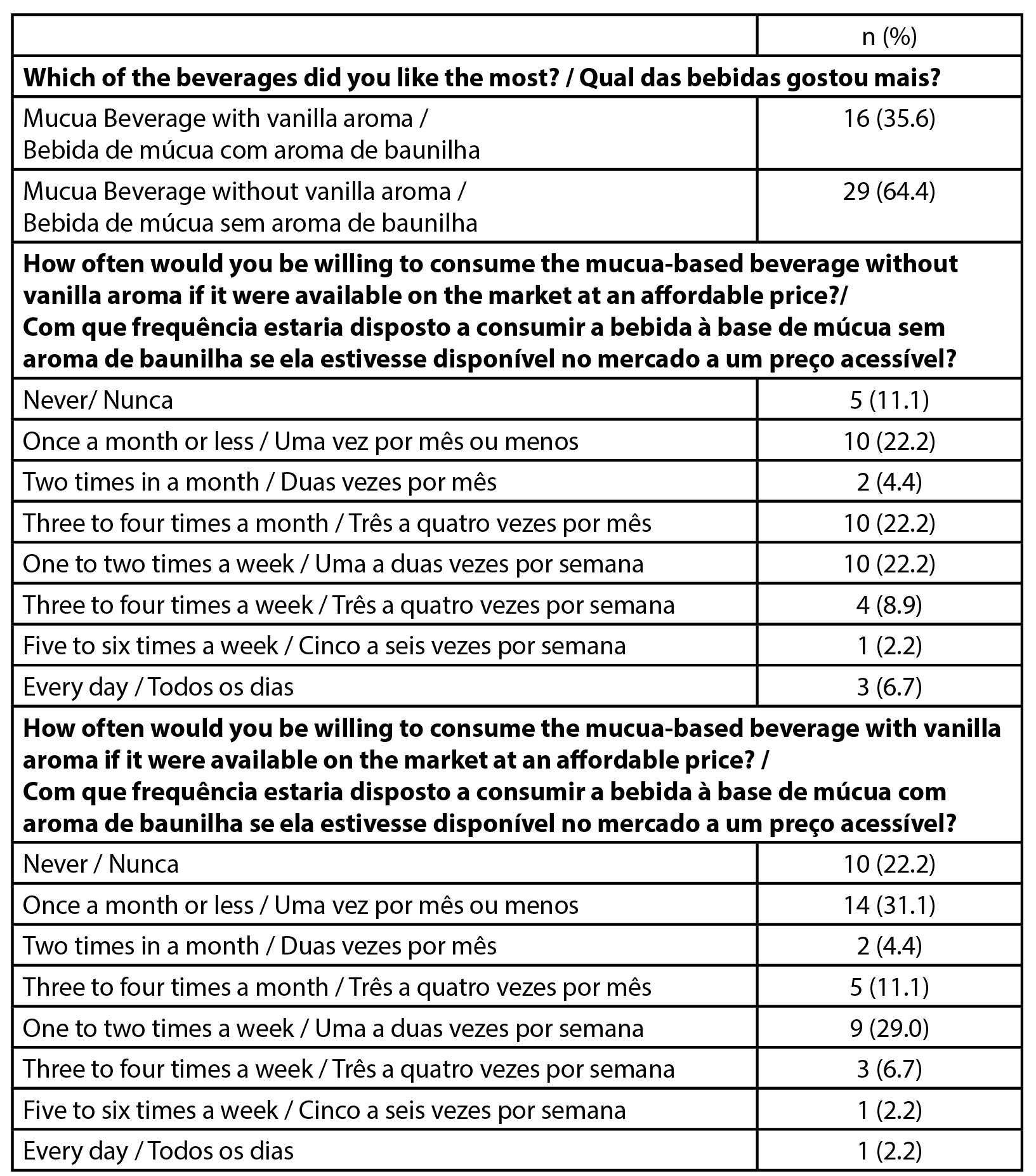 |
If the mucua beverage without vanilla flavoring were available in the market at an affordable price, 33.1% of the tasters would be willing to consume it one to four times a week. In the case of the beverage with vanilla flavoring, this value is 35.7% for a consumption willingness of one to four times a week. There seems to be a potential interest in incorporating this beverage into the weekly consumer routine if it were offered at a competitive price. In the case of mucua beverage without vanilla flavoring, although the proportion is slightly smaller (33.1%), a substantial portion of tasters demonstrated interest in consuming it as often. This may indicate that, despite the preference for the mucua beverage with vanilla flavoring, there is a segment of the public that also appreciates the vanilla-free mucua beverage.
When asked about the price they would pay for these beverages, only eight responses were obtained, none of which exceeded €3 per liter for both beverages. This suggests that to ensure the acceptance and commercial viability of these beverages, it is important to consider consumer price sensitivity and adjust the pricing accordingly. Furthermore, the decision to purchase mucua products may depend on their properties, such as their pleasant taste and nutritional benefits (21). In this sense, making the fruit and its properties better known may be important for the launch of new mucua products, including beverages in Portugal. It should also be noted that the price that the participants were willing to pay (€3/liter) is much higher than the production costs of the drinks (although this estimate was made using only the direct costs of the ingredients and also on a small scale). This could be an indicator of an interesting profit margin with potential for market exploration.
Overall, these results highlight the fundamental importance of taste as a determining positive factor in accepting beverages, as well as the need to address the issue of texture, which seems to be a common and prominent negative aspect. This can guide future adjustments in beverage formulations, aiming to optimize both texture and taste in order to better serve consumers' preferences. In addition, the willingness for regular consumption, provided that the price is affordable, emphasizes the importance of balancing the value perceived by consumers with the commercialization of these beverages.
It is also important to mention some limitations of this study. The reduced sample size (n = 45) limits the representativeness of the results. A larger sample could offer a broader view of consumer preferences and attitudes. However, the sample size of this study is sufficient to perform sensory analysis (20). Another limitation is clear from the profile of participants, that is, university students and university collaborators. This may limit the generalization of results to the general population, as different demographic groups can have different preferences (22). In addition, acceptability tests were performed in a controlled environment, which may not completely reflect the real consumer situations. Consumer preferences and attitudes can be influenced by food packaging, as well as by contextual factors outside of the packaging. Consumer preferences and attitudes can be influenced by food packaging, as well as by contextual factors outside the testing environment, including participants' subjective assessment of beverage attributes can be influenced by personal factors and individual expectations, potentially introducing bias in answers (23,24). In addition, the willingness to consume beverages may not necessarily translate into actual market purchase behavior. Finally, it is important to note that the calculation of the costs of "mucua" beverages does not reflect their true value, as costs such as equipment acquisition for large-scale production, human resources, marketing, rental of spaces/facilities, transportation, among others, were not included, which would increase their production cost. Future studies with larger, diverse samples and broader methods can help overcome some of these limitations. A strong point to highlight is the fact that vanilla flavoring was used, this can enhance the perception of sweetness and improve the flavor of drinks, allowing the development of drinks with less added sugar (25). Furthermore, the vanilla flavoring has this effect even when combined with sweeteners (26). In this way, this study could serve as a basis for comparing and testing other types of sweeteners in the development of mucua-based drinks with vanilla flavoring and reduced or zero sugar content.
Conclusion
In this study, two mucua-based beverages were developed, one with vanilla flavoring and another without. Despite there being no significant differences between the attributes of the beverages when compared, the one containing vanilla flavoring scored higher in appearance and sweetness, while the one without vanilla flavoring scored higher in taste. Certain attributes that need improvement were identified, especially the texture. It was also found that the tasters would be willing to consume the beverages on a weekly basis and pay approximately €3 per liter for them. This study suggests a potential favorable consumer acceptance of such beverages in Portugal; however, further research is needed, particularly a larger and geographically diverse study to establish a more robust market analysis
Authors Contributions Statement
Conceptualization and supervision, L.O.; data collection, A.M., E.G. and I.L.; methodology and formal analysis, L.O.; writing, review and editing L.O..; writing original draft preparation, L.O., S.B., A.M., E.G. and I.L. All authors have read and agreed to the published version of the manuscript.
Funding
This research was funded by the Fundação para a Ciência e a Tecnologia (FCT) through the CBIOS projects DOI 10.54499/ UIDB/04567/2020 and DOI 10.54499/UIDP/04567/2020.
Acknowledgements
The authors would like to express their thanks to all participants in the study.
Conflict of Interests
The authors declare there are no financial and/or personal relationships that could present a potential conflict of interests.
References
1. Moskowitz, H. R., Reisner, M., Itty, B., Katz, R., & Krieger, B. (2006). Steps towards a consumer-driven ‘concept innovation machine’ for food and drink. Food Quality and Preference, 17(7), 536-551. doi:https://doi.org/10.1016/j.foodqual.2006.01.002
2. Banco de Portugal. (2023). Conversor de moeda. Retrieved from https://www.bportugal.pt/page/conversor-de-moeda
3. Research and Markets. (2023). Fruit Juice Market: Global Industry Trends, Share, Size, Growth, Opportunity and Forecast 2023-2028. https://www.researchandmarkets.com/reports/5732908/fruit-juice-market-global-industry-trends
4. Heng, Y., House, L. A., & Kim, H. (2018). The Competition of Beverage Products in Current Market: A Composite Demand Analysis. Agricultural and Resource Economics Review, 47(1), 118-131. doi:10.1017/age.2017.10
5. Gupta, A., Sanwal, N., Bareen, M. A., Barua, S., Sharma, N., Joshua Olatunji, O., Opeyemi, Prakash, N. & Sahu, J. K. (2023). Trends in functional beverages: Functional ingredients, processing technologies, stability, health benefits, and consumer perspective. Food Research International, 170, 113046. doi:https://doi.org/10.1016/j.foodres.2023.113046
6. Putnik, P., Pavlić, B., Šojić, B., Zavadlav, S., Žuntar, I., Kao, L., Kitonić, D., & Kovačević, D. B. (2020). Innovative Hurdle Technologies for the Preservation of Functional Fruit Juices. Foods, 9(6). doi:10.3390/foods9060699
8. Chen, L., Wu, W., Zhang, N., Bak, K. H., Zhang, Y., & Fu, Y. (2022). Sugar reduction in beverages: Current trends and new perspectives from sensory and health viewpoints. Food Research International, 162, 112076. doi:https://doi.org/10.1016/j.foodres.2022.112076
8. Vilas-Boas, A. A., Magalhães, D., Campos, D. A., Porretta, S., Dellapina, G., Poli, G., Istanbullu, Y., Demir, S., San Martín, Á. M., García-Gómez, P., Mohammed, R. S., Ibrahim, F. M., El Habbasha, E. S. & Pintado, M. (2022). Innovative Processing Technologies to Develop a New Segment of Functional Citrus-Based Beverages: Current and Future Trends. Foods, 11(23). doi:10.3390/foods11233859
9. Rahul, J., Jain, M. K., Singh, S. P., Kamal, R. K., Anuradha, Naz, A., Gupta, A. K., & Mrityunjay, S. K. (2015). Adansonia digitata L. (baobab): a review of traditional information and taxonomic description. Asian Pacific Journal of Tropical Biomedicine, 5(1), 79-84. doi:https://doi.org/10.1016/S2221-1691(15)30174-X
10. Abere, M., Eshete, A., & Alemu, A. (2022). Traditional uses and local management practices of Adansonia digitata L. in different ethnic groups of Quara wereda, North West low land of Ethiopia. Trees, Forests and People, 7, 100188. doi:https://doi.org/10.1016/j.tfp.2021.100188
11. Jornal de Angola. (2019). Embondeiro na lista das espécies em extinção. Retrieved from https://www.jornaldeangola.ao/ao/noticias/detalhes.php?id=425178
12. Pander, H., & Cascais, A. (2016). Imbondeiros: frutos saudáveis e com potencial económico. Retrieved from https://www.dw.com/pt-002/frutos-dos-imbondeiros-j%C3%A1-d%C3%A3o-emprego-a-muitos-africanos/a-19451645
13. Debelo, H., Fiecke, C., Terekhov, A., Reuhs, B., Hamaker, B., & Ferruzzi, M. G. (2023). Compositional analysis of phytochemicals and polysaccharides from Senegalese plant ingredients: Adansonia digitata (baobab), Moringa oleifera (moringa) and Hibsicus sabdariffa (hibiscus). NFS Journal, 32, 100144. doi:https://doi.org/10.1016/j.nfs.2023.100144
14. Stadlmayr, B., Wanangwe, J., Waruhiu, C. G., Jamnadass, R., & Kehlenbeck, K. (2020). Nutritional composition of baobab (Adansonia digitata L.) fruit pulp sampled at different geographical locations in Kenya. Journal of Food Composition and Analysis, 94, 103617. doi:https://doi.org/10.1016/j.jfca.2020.103617
15. Silva, M. L., Rita, K., Bernardo, M. A., Mesquita, M. F. d., Pintão, A. M., & Moncada, M. (2023). Adansonia digitata L. (Baobab) Bioactive Compounds, Biological Activities, and the Potential Effect on Glycemia: A Narrative Review. Nutrients, 15(9), 2170. https://doi.org/10.3390/nu15092170.
16. Adedokun, T. O., Matemu, A., Höglinger, O., Mlyuka, E., & Adedeji, A. (2022). Evaluation of functional attributes and storage stability of novel juice blends from baobab, pineapple, and black-plum fruits. Heliyon, 8(5), e09340. doi:https://doi.org/10.1016/j.heliyon.2022.e09340
17. Badejo, A. A., Duyilemi, T. I., Falarunu, A. J., & Akande, O. A. (2020). Inclusion of Baobab (Adansonia digitata L.) Fruit Powder Enhances the Mineral Composition and Antioxidative Potential of Processed Tigernut (Cyperus esculentus) Beverages. Preventive Nutrition and Food Science, 25(4), 400-407. doi:10.3746/pnf.2020.25.4.400
18. Kivoloka, F. (2015). Estudo para valorização da polpa do fruto da Adansonia digitata L. (Mestrado em Engenharia Alimentar - Qualidade e Segurança Alimentar). Universidade de Lisboa, Lisboa. http://hdl.handle.net/10284/3734
19. Tomás, A., & Oliveira, L. (2023). Mucua: Sensory analysis of the fruit of Adansonia digitata L.(Baobab) in natura. Biomedical and Biopharmaceutical Research, 20(2), 1-11. https://www.alies.pt/BBR%20Editions/Vol-20-2-2023/bbr.20.2.318.pdf
20. Teixeira, L. V. (2013). Análise sensorial na indústria de alimentos. Revista do Instituto de Laticínios Cândido Tostes, 64(366), 10. Retrieved from https://www.revistadoilct.com.br/rilct/article/view/70
21. Horlu, G. S. A., Egbadzor, K. F., Akuaku, J., & Akumah, A. M. (2023). Reasons influencing consumers’ choice of baobab (Adansonia digitata L.) products: Evidence from four countries in sub-Saharan Africa. Trees, Forests and People, 12, 100393. doi:https://doi.org/10.1016/j.tfp.2023.100393
22. Livingstone, K. M., Lamb, K. E., Abbott, G., Worsley, T., & McNaughton, S. A. (2020). Ranking of meal preferences and interactions with demographic characteristics: a discrete choice experiment in young adults. International Journal of Behavioral Nutrition and Physical Activity, 17(1), 157. doi:10.1186/s12966-020-01059-7
23. Mouta, J. S., de Sá, N. C., Menezes, E., & Melo, L. (2016). Effect of institutional sensory test location and consumer attitudes on acceptance of foods and beverages having different levels of processing. Food Quality and Preference, 48, 262-267. doi:https://doi.org/10.1016/j.foodqual.2015.10.002
24. Rai, S., Wai, P. P., Koirala, P., Bromage, S., Nirmal, N. P., Pandiselvam, R., . . . Mehta, N. K. (2023). Food product quality, environmental and personal characteristics affecting consumer perception toward food. Frontiers in Sustainable Food Systems, 7. doi:10.3389/fsufs.2023.1222760
25. Bertelsen, A. S., Mielby, L. A., Alexi, N., Byrne, D. V., & Kidmose, U. (2020). Individual Differences in Sweetness Ratings and Cross-Modal Aroma-Taste Interactions. Foods (Basel, Switzerland), 9(2), 146. doi:10.3390/foods9020146
26. Bertelsen, A. S., Zeng, Y., Mielby, L. A., Sun, Y.-X., Byrne, D. V., & Kidmose, U. (2021). Cross-modal Effect of Vanilla Aroma on Sweetness of Different Sweeteners among Chinese and Danish Consumers. Food Quality and Preference, 87, 104036. doi:https://doi.org/10.1016/j.foodqual.2020.104036
